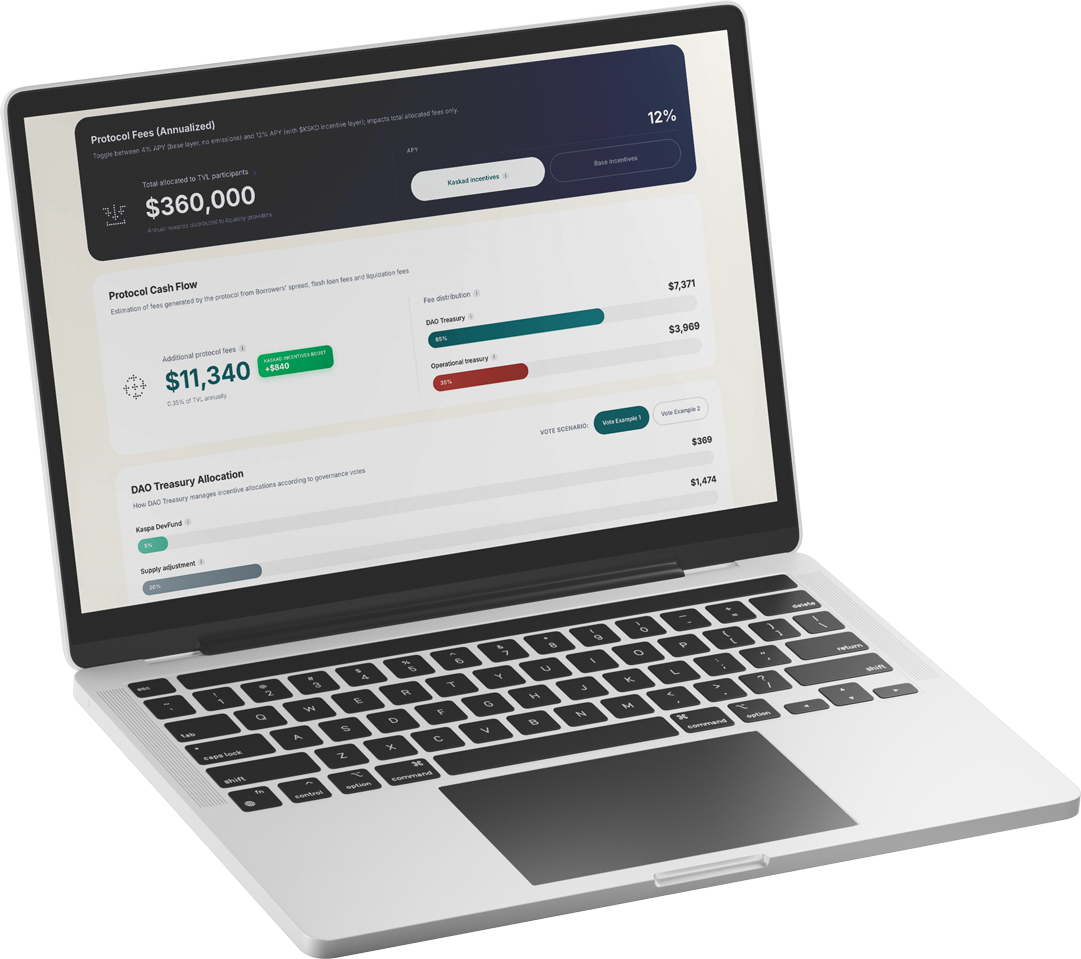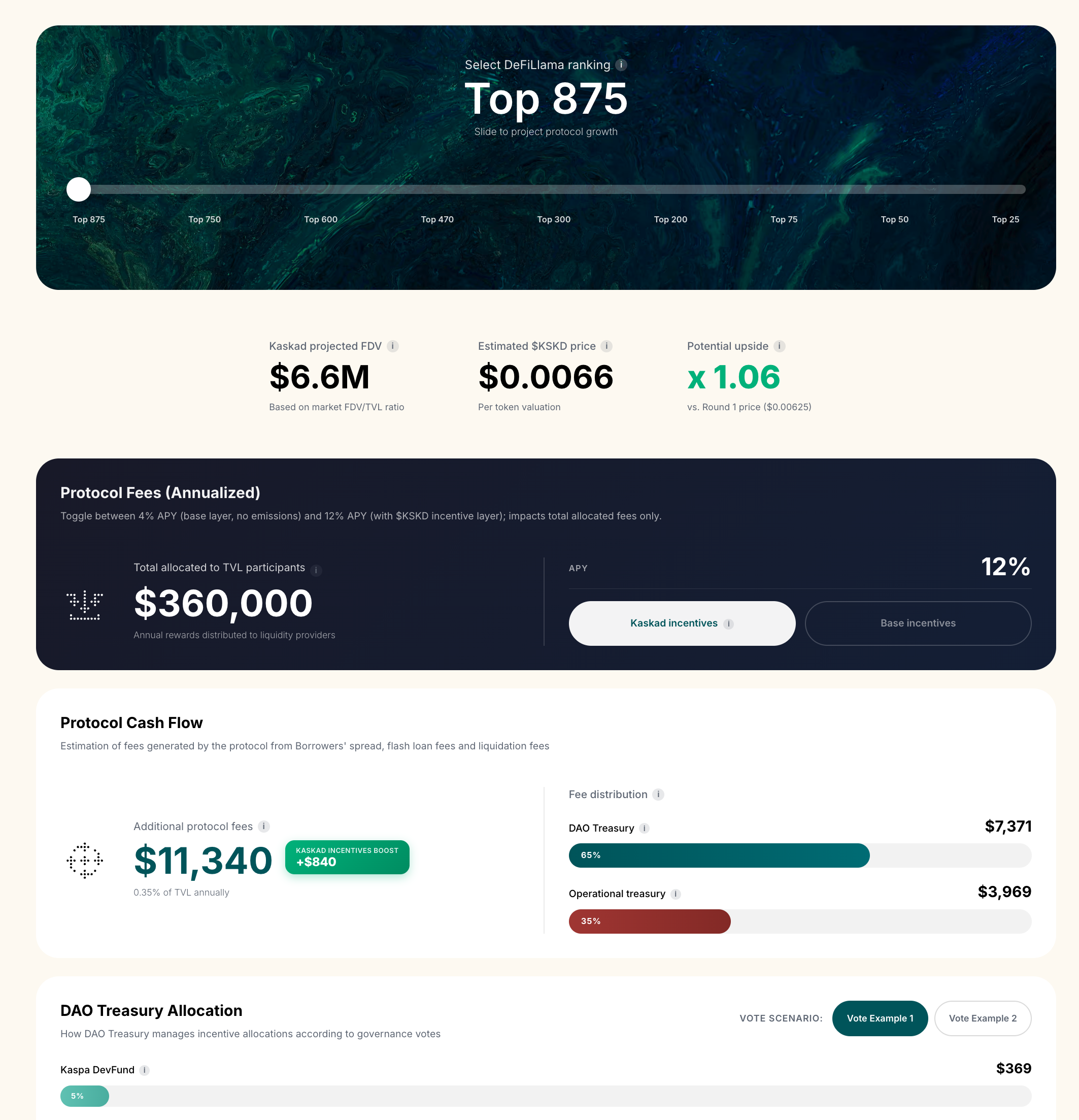Part 01 - Kaskad's Incentive Layer
Kaskad is all about incentivizing on-chain participation. Our goal is simple: increase liquidity formation and overall Kaspa adoption.
Active on-chain participation targets TVL Participants and Voters.
Let's put you in the shoes of each one and explore together what you can do!
| Participation Incentives and Governance
Kaskad's incentives for suppliers
The TVL participant role is at the heart of Kaskad's tokenomic. It is the protocol's way of incentivizing liquidity formation and democratizing the usage of lending on Kaspa.
So how do you become a TVL participant? Simple!
01 • Provide a minimum of $100 worth of assets
Now, Kaskad is all about sustained liquidity provision over time, so providing $100 of assets for just a tiny period of time is not enough, otherwise a lot of users would try to exploit this rule.
02 • Maintain your liquidity provision over time: the role of Uptime
So how do we solve this?
Enter Uptime. Remember, Kaskad operates under an epoch-based system, which means that on-chain activity over time matters. This is why the minimal value of your asset provision is time-dependent.
The amount is not representative of the actual allocation and is presented as such for educational purposes only. Actual incentive allocations depend on many factors such as user TVL share and overall platform participation metrics.
03 • Adjust the parameter as a Voter
While $100 is the absolute minimum supplied position for eligibility, Voters can adjust and tweak this parameter up to ± 15% every epoch.
But that's not all: remember Kaskad incentivizes liquidity formation, so the demand is as much as important as the supply.
Kaskad's extra incentives for borrowers
The health of a lending platform depends on the balance between liquidity provision from suppliers and liquidity utilization from borrowers. This is why the Kaskad protocol encodes borrowing behaviour with a special treatment: borrowers can claim additional incentives if they fulfill specific eligibility conditions.
Let's see what the conditions to receive this extra allocation are:
01 • Borrow against your supplied assets
In Kaskad, you can only borrow against the value of the assets you've supplied first. This initial supplied value determines the amount you can ultimately borrow, called loan-to-value or LTV, as well as your health factor.
Our protocol incentivizes this initiative by allowing borrowers to claim extra incentive allocations, granted they borrow with at least 15% LTV.
But that's not sufficient. Remember the uptime thing?
02 • Borrowing uptime
For borrowers, the protocol's rules request a minimum of 50% borrowing uptime (fixed lower bound) per epoch in order to maintain a borrower's position and claim extra incentives.
The amount is not representative of the actual allocation and is presented as such for educational purposes only. Actual incentive allocations depend on many factors such as user TVL share and overall platform participation metrics.
03 • Adjust the parameters as a Voter
While 15% LTV and 50% borrowing uptime are minimum bounded parameters, Voters can adjust and tweak this parameter up to ± 10% every epoch, but they can never fall below the initial range.
| Governance-controlled Emission Split
In Kaskad, a portion of the default $KSKD monthly emissions are allocated to suppliers, and another portion is allocated to incentivize borrowing behaviour.
By default and for each epoch, 40% of the monthly $KSKD emission are allocated to Suppliers, and 60% to borrowers. Ultimately, Voters can adjust the supplier-to-borrower allocation ratio within a 40% - 60% band.
Is that all? No, we have a final twist: on Kaskad, the borrower allocation is not automatically allocated in its totality, it is adjusted dynamically with actual borrowing demand. Meaning, there will be times where the unused borrower allocations will be able to be recycled.
Let’s learn how it works, and what Voters can do about it.
| Recycling of Undistributed Emissions
When borrower utilization is below the active cap, the corresponding fraction of emissions remains undistributed and is redirected automatically to a DAO Treasury. Subsequent governance votes determine redistribution between:
- additional incentives to be allocated for the next epoch, and
- supply-adjustment mechanisms, for token-supply calibration processes.
| Governance over the Kaskad Protocol Resources
Kaskad generates protocol fees from lending activity on the platform (Interest Spread Fees, Flash-loan fees and Liquidation fees). These fees can be in many forms, such as $IGRA, $IKAS, $USDC, $KSKD, etc.
To support long-term liquidity formation, governance, and continued development right from the start, after the TGE, these fees are immutably split between:
- the DAO Treasury (governed by the Voters) for 65% of the total resources, and
- the Operational Treasury (under Kaskad’s development contributors management) for the remaining 35%.
As always, the parameters within the DAO Treasury obey a bounded-governance system, meaning Voters can adjust them within a preset of ranges:
- Additional incentives to TVL Participants: minimum 50%, adjustable up to 80%
- Token-supply calibrations (amount sent to burn address): minimum 15%, adjustable up to 20%
- Kaspa Core Funding wallet (to support L1 R&D): minimum 5%, adjustable to 7.5%
Part 02 - How to become a voter
The Voter role is the most important role on Kaskad. Think of it as an empowered TVL participant role. If you want to vote on Kaskad, you have to show real proof of participation and commitment to the platform, both of which will be reflected in your Voting Score. Let's see how this score works.
| Voting Score
Each active participant’s Voting Score is calculated per epoch and is the combination of their TVL Score (TVL Share per epoch) and Loyalty Score (percentage of the KSKD Liquid Staking Pool and Total number of Votes).
Part 03 - Activity Milestone Incentives
With Kaskad, we’re introducing an exclusive milestone-based incentives system that connects the protocol’s liquidity formation with the on-chain contributions of its active participants.
These milestones represent concrete achievements such as total value locked (TVL), sustained liquidity, or adoption goals.
After milestone resources are released to the DAO Treasury, Voters may determine their distribution within predefined governance bounds.
Recipients include:
- TVL Participants– (suppliers and borrowers maintaining eligible liquidity positions),
- Vested $KSKD Holders– (contributors and community members with time-locked allocations).
All allocations require explicit on-chain governance execution, meaning that each distribution reflects both the magnitude of the milestone and the proportional participation of contributors.
Let’s now see how this is applied with a concrete example. Say the TVL on the Kaskad platform has reached $50M, and that it has been challenged and verified. Then, a specific Growth Pool will unlock a predetermined budget in non-$KSKD assets ($9,800$ in this example) that Voters will need to allocate via bounded-governance rules (range ratio between 35% and 65%)
After milestone resources are released to the DAO Treasury, Voters may determine their distribution within predefined governance bounds.
Recipients include:
- TVL Participants– (suppliers and borrowers maintaining eligible liquidity positions),
- Vested $KSKD Holders– (contributors and community members with time-locked allocations).
Let’s now see how this is applied with a concrete example. Say the TVL on the Kaskad platform has reached $50M, and that it has been challenged and verified. Then, a specific Growth Pool will unlock a predetermined budget in non-$KSKD assets ($9,800 in this example) that Voters will need to allocate via bounded-governance rules (range ratio between 35% and 65%)
Let’s now talk about the $KSKD token supply, its distribution and other parameters that are involved during this development phase.
Part 04 - Supply and distribution
The total supply of $KSKD is capped at 1 billion tokens, distributed across key categories:
Details on Distribution, Emissions, Vestings and KPI conditions
Round 1 - Community & strategic partners fundraising
The fundraising model of Kaskad is designed to achieve decentralised capital formation while maintaining operational continuity during the protocol’s initial phases. A total of 20 % of the total supply (equivalent to 200 million $KSKD) is reserved for this purpose, following the fixed-supply logic established at deployment. The Community Round targets a raise of $1.25M at a $6.25M valuation, corresponding to a $12.5M fully diluted valuation (FDV) at the token generation event.
Participation is open primarily to community members and early ecosystem partners, with an individual allocation limit of $150,000. No such limit exists for DAO VCs, since those entities represent a vast panel of pooled individual participants. Our approach prioritises early involvement of users who contribute to the protocol’s adoption rather than short-term speculative capital.
The first round obeys to specific vesting conditions:
- TGE unlock (= launch event): 10% of total allocation
- Cliff Period (= period without unlock) - 6 monthsVesting (post cliff): 18 months
- Both the cliff and linear vesting periods include access Milestones allocation from the Milestone
- Incentives based on the user’s $KSKD vested share.
Meaning: when a specific milestone is hit on the platform, [vested $KSKD holders] will be able to claim a special Milestone allocation based on their vested $KSKD share (Milestone Triggers detailed in the upcoming whitepaper).
Round 2 - Public fundraising
The Public Round is intended to extend platform access to a wider base of ecosystem participants while maintaining consistency with the project’s long-term incentive alignment model. This round is structured as a late-entry opportunity at a valuation that reflects progress between the Community Round and the anticipated Token Generation Event (TGE).
The Public Round targets $375,000 in contributions at an $11.5M USD FDV. A total of 3.26% of the total supply is allocated to this round, with a token price of $0.0115 per token.
Tokens distributed in this round follow a vesting structure designed to facilitate responsible distribution and discourage short-term speculative pressure. 20% of the allocation is released at TGE, followed by a three-month cliff and twelve months of linear vesting thereafter.
Just like in round 1, both the cliff and linear vesting periods include access to Milestone allocations from the MilestoneIncentives module,based on the user’s $KSKD vested share.
Community Rounds Parameters - Summary
The details of the fundraising rounds are summarized in the table below.
Use of Proceeds
The proceeds are distributed across three primary expenditure domains. Approximately 36.3 % (≈ $590 000) directly supports platform management and growth, covering legal structuring, audits, User Onboarding Phase, and targeted marketing or security programs. Around 15.4 % ($250,000) is allocated to the establishment of initial liquidity on decentralised exchanges to facilitate early price discovery and transaction stability. This means that an equivalent value ($250,000) of $KSKD will be paired to create trading pairs on Decentralized Exchanges. In total, the platform management and liquidity provision account for 51,7% of the funds raised.
The remaining 48.6 % (≈ $785,000 if hard cap is reached) funds ongoing development, infrastructure maintenance, and team operations over the first twelve to twenty-four months.
All raised funds are held under multi-signature control by POW Incentives S.A., the protocol’s registered Token entity. Financial communications regarding the use of proceeds are conducted directly and publicly by the core team, accompanied by verifiable proof of expenditure such as transaction records or attested reports. The structure will maintain transparency without dependence on DAO activation or external intermediaries, offering a continuous and verifiable record of fund deployment throughout Kaskad’s operational phases.
Protocol Incentives for TVL participants – 39% - $KSKD Emission Schedule
Emissions follow a predefined schedule tied to the protocol’s adoption curve and user participation metrics. Excess of $KSKD emissions flow back to the DAO Treasury and their future usage is under the [voters]’ governance.
Max monthly $KSKD emission rate - a curve is applied based on real-time TVL on the platform.
Emissions are released at the beginning of each epoch and allocated linearly to eligible participants according to proportional activity and position data.
Bonding – 1,24%
The $KSKD bounding allocation is reserved for future token sales at discount and will follow the vesting conditions below:
3–7 days vesting after purchase (short-term lock, no cliff). Vesting of Bonding allocation before purchase is planned for 18 months.
TVL Partner Program – 3%
The TVL Partner Program is designed to onboard institutional profiles looking for enhanced yield strategies on the Kaskad platform.
3% of the total supply is reserved to that effect with a targeted APY of 10% paid in $KSKD over a 3 to 6 month period.
Participants of this program must retain their TVL deposit for the total duration of the vesting period in order to receive their $KSKD allocation.
TVL Partners will be disclosed publicly in advance.
Advisors - 3%
A total of 3% of the supply is reserved for advisory support. Kaskad requests strict KPI to maintain the Advisory allocation and contributions are reevaluated monthly. Vesting Summary
Protocol Incentives for TVL participants – 39% - $KSKD Emission Schedule
Emissions follow a predefined schedule tied to the protocol’s adoption curve and user participation metrics. Excess of $KSKD emissions flow back to the DAO Treasury and their future usage is under the [voters]’ governance.
Circulating Supply at TGE (% of total supply)
Current Advisory Board










